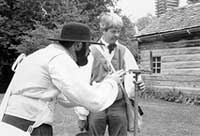
 |
| Surveying
re-enacted
Robert Church |
By many accounts, the lives of the surveyors and their crew members were frequently rough. They often lived on salt pork and beans for weeks at a time. They suffered the elements - blazing sun, driving rain, and harsh winter winds - with inadequate clothing and shelter.
The land they crossed was often difficult, presenting them with brambles, biting insects, poison ivy, swamps, rivers, muck, and tall grass that was difficult to walk through, let alone survey. In letters to his father, a young Benjamin Lacy, who was on a survey team in Minnesota in 1858, wrote:
Mosquitos would swarm into the tent....I could not cover myself in any way to keep them out... The nights... (would) sometimes be so hot and close that a man could not remain covered long; then came the feast of the mosquitoes!Deputy Surveyor, Henry A. Wiltse (1847) writes from Iowa on August 20, 1847, that:Got into camp about 9 o'clock & eat pork & beans enough to kill a doz. aldermen.
We stopped for the night at a house that swarmed with bed-bugs. It is unnecessary to say that we suffered like martyrs.
We have on different occasions walked as much as 30 m (miles) in a day.
We have had to wade 1/2 mile through water 3 or 4 feet deep cold enough to freeze one to death. We get wet early in the morning, remain so all day; build a big fire at night, sit & stand round to dry till we get tired, then go to sleep in our wet clothes, seldom change or pull off.....the chains and pins are made of iron, & not having any gloves they nearly froze my hands.
There are some things in it that are pleasant, but taking it on the whole it (surveying) is disagreeable and the hardships are numerous.
Every member of my party was crippled or in some way disabled by the difficult service which they had already performed. Worn out by fatigue and hardship, and nearly destitute of clothes, they had now to make a forced march of three days for the lake in search of provision, of which, during that three days, they had not a mouthful.Despite the hardships, the surveyors were usually good woodsmen who faithfully recorded the presence of common trees and other vegetation in the territories they surveyed.I contracted to execute this work at ten dollars per mile, the least possible rate at which it could have been executed; but would not again, after a lifetime of experience in the field, and a great fondness for camp life, enter upon the same, or a similar survey at any price whatever.
Today, ecologists use land survey records along with historical accounts (journals of settlers and explorers), and other types of data, to identify and map plant communities that existed prior to European settlement.
Click here for a land survey hands-on activity.
|
|
Copyright © 2000 Illinois State Museum